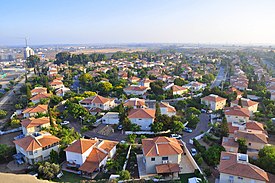Yavne
יַבְנֶה | |
|---|---|
| Hebrew transcription(s) | |
| • ISO 259 | Yabne |
 | |
| Coordinates: 31°53′N 34°44′E / 31.883°N 34.733°E | |
| Country | |
| District | Central |
| Founded | 2000 BCE (Canaanite city) 37 BCE (Herodian rule) 7th century Islamic period (Arab village) 1949 (Israeli city) |
| Government | |
| • Mayor | Roei Gabay |
| Area | |
| • Total | 10,700 dunams (10.7 km2 or 4.1 sq mi) |
| Population (2022)[1] | |
| • Total | 56,232 |
| • Density | 5,300/km2 (14,000/sq mi) |
| Ethnicity | |
| • Jews and others | 99.9% |
| • Arabs | 0.1% |
| Website | www |
Yavne (Hebrew: יַבְנֶה) is a city in the Central District of Israel. In 2022, it had a population of 56,232.[1]
Modern Yavne was established in 1949. It is located near the ruins of the ancient town of Yavne (known also as Jamnia and Jabneh), later the village of Yibna, and today the archeological site of Tel Yavne. Ancient Yavne holds a special place in Jewish history because of the ancient town's contribution to Judaism's recovery and reconstitution under sages ben Zakkai and Gamaliel II following the destruction of the Second Temple. This period, sometimes known as the "Yavne period", became a crucial mark in the development of Rabbinic Judaism.[2][3][4] The city has a history of producing wine throughout much of antiquity, as indicated by both archeological findings and ancient sources.[5]
- ^ a b c "Regional Statistics". Israel Central Bureau of Statistics. Retrieved 21 March 2024.
- ^ Katz, Steven T., ed. (2006). The Cambridge History of Judaism: Volume 4: The Late Roman-Rabbinic Period. Vol. 4. Cambridge: Cambridge University Press. p. 268. doi:10.1017/chol9780521772488. ISBN 978-0-521-77248-8.
Under the leadership of R. Yohanan ben Zakkai and his circle at Yavneh, Judaism sought to reconstitute itself and find a new equilibrium in the face of the disaster of 70.
- ^ Neusner, Jacob (2016-09-26). "The Formation of Rabbinic Judaism: Yavneh (Jamnia) from A.D. 70 to 100". In Haase, Wolfgang (ed.). Religion (Judentum: Palästinisches Judentum [Forts.]) (in German). De Gruyter. doi:10.1515/9783110839043-002. ISBN 978-3-11-083904-3.
- ^ Joshua Schwartz; Peter J. Tomson, eds. (2018). Jews and Christians in the first and second centuries : the interbellum 70-132 AD. Leiden, The Netherlands: Brill. ISBN 978-90-04-34986-5. OCLC 988856967.
- ^ "Largest wine factory in the world from Byzantine period unearthed". The Jerusalem Post | Jpost.com. Retrieved 2023-01-05.


